ROLLOVER - ROOF CRUSH
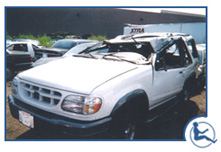 If a driver or passenger is killed or paralyzed in a rollover accident, and the roof and its support pillars show considerable buckling and downward crushing, then the various compromises in roof strength may be a likely defect issue. Ford had long ago noted that it was unjust to penalize occupants who wore their lap and shoulder belts, and thus were seated erect, if the roof was so weak that it buckled down on them. If a driver or passenger is killed or paralyzed in a rollover accident, and the roof and its support pillars show considerable buckling and downward crushing, then the various compromises in roof strength may be a likely defect issue. Ford had long ago noted that it was unjust to penalize occupants who wore their lap and shoulder belts, and thus were seated erect, if the roof was so weak that it buckled down on them.
Many vehicles have a weak roof structure comprised of thin sheetmetal semi-tubular elements, with many notches and dimples and hole cutouts, as weak points that cause the roof to buckle and crush downward in a rollover accident, imposing injury-causing forces downward onto the occupant's head and spine. Some designs have windshield pillars that are only reinforced part-way up, and predictably will buckle at that location.
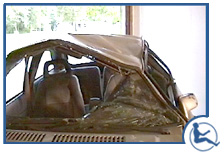 
Safer designs have reinforced roof pillars with full-length internal baffle plates and/or are filled with rigid foam (which can triple their strength), and closed-section (like an " O ") rather than open-section (like a " C ") tubular windshield headers and roof siderails, plus lateral side-to-side cross-members, and reinforcing gussets at the connections. Thus, stronger roofs will help minimize the downward and lateral roof crush that causes head and cervical injuries, and will safely maintain the "survival space" or "non-encroachment zone" for the driver and passengers.
Federal Safety Standard FMVSS 216 notes that "serious injuries are more frequent when the roof collapses" , yet this minimum standard only requires a slowly-applied minimal load to the front corner of the roof. There is no dynamic rollover crash test requirement with test dummies to more accurately simulate what happens in real-world accidents.
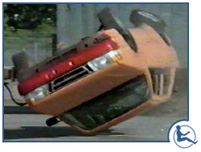 Safer roof designs have been documented since the 1950's when automakers conducted dynamic vehicle rollover tests (adjacent photo shows a SAAB in a dynamic rollover test), and then again in the Experimental (Enhanced) Safety Vehicle Program that began in the early 1970's. In addition to stronger roofs, the use of laminated glass-plastic side-window glass, side curtain airbags, and energy-absorbing padded vehicle interiors can all reduce occupant injuries during rollovers. Safer roof designs have been documented since the 1950's when automakers conducted dynamic vehicle rollover tests (adjacent photo shows a SAAB in a dynamic rollover test), and then again in the Experimental (Enhanced) Safety Vehicle Program that began in the early 1970's. In addition to stronger roofs, the use of laminated glass-plastic side-window glass, side curtain airbags, and energy-absorbing padded vehicle interiors can all reduce occupant injuries during rollovers.
>> 2007 Jury Verdict for Plaintiff in Louisiana Rollover Accident <<
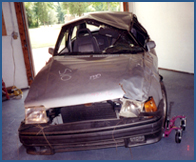 This rollover accident occurred on May 25th, 1996, near Tallulah, Louisiana. David Garcia, wearing his lap and shoulder seatbelts, was driving a 1989 Ford Escort 2-door hatchback when, to avoid another vehicle that had cut into his lane, the Escort left the road and rolled over at about 35 mph on the grassy center median. In the rollover, the Ford Escort's roof buckled and crushed downward into his "survival space", causing forces that fractured his cervical vertebrae, rendering David into a quadriplegic. The trial was held in Tallulah, Louisiana, in June of 2007, and the jury returned a verdict for the Plaintiff Garcia. This rollover accident occurred on May 25th, 1996, near Tallulah, Louisiana. David Garcia, wearing his lap and shoulder seatbelts, was driving a 1989 Ford Escort 2-door hatchback when, to avoid another vehicle that had cut into his lane, the Escort left the road and rolled over at about 35 mph on the grassy center median. In the rollover, the Ford Escort's roof buckled and crushed downward into his "survival space", causing forces that fractured his cervical vertebrae, rendering David into a quadriplegic. The trial was held in Tallulah, Louisiana, in June of 2007, and the jury returned a verdict for the Plaintiff Garcia.
Byron Bloch testified as an expert in Auto Safety Design and Vehicle Crashworthiness, and pointed out the roof's defective design, including its open-section windshield header and A-pillar with only minimal internal reinforcement of just the bottom six inches. Bloch also showed safer alternative designs that were state-of-the-art, including box-section windshield headers. He noted that though the vehicle complied with FMVSS 216, its roof structure was clearly inadequate.
>> 2007 Jury Verdict for Plaintiff in New Jersey Rollover Accident <<
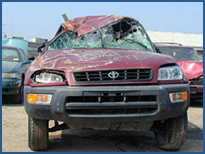 This rollover accident occurred on June 8th, 2002, on the Garden Sate Parkway in New Jersey. William Scott was the right-front passenger in a 1999 Toyota RAV4 Sport Utility Vehicle (SUV) that was impacted in its rear side by an adjacent vehicle, causing the RAV4 to rollover. The roof buckled and crushed downward into the "survival space", causing a fracture of William Scott's cervical vertebrae, rendering him a quadriplegic. The trial was held in New Brunswick, New Jersey, in March and April of 2007, and the jury returned a verdict for the Plaintiff Scott. This rollover accident occurred on June 8th, 2002, on the Garden Sate Parkway in New Jersey. William Scott was the right-front passenger in a 1999 Toyota RAV4 Sport Utility Vehicle (SUV) that was impacted in its rear side by an adjacent vehicle, causing the RAV4 to rollover. The roof buckled and crushed downward into the "survival space", causing a fracture of William Scott's cervical vertebrae, rendering him a quadriplegic. The trial was held in New Brunswick, New Jersey, in March and April of 2007, and the jury returned a verdict for the Plaintiff Scott.
Byron Bloch testified as an expert in Auto Safety Design and Vehicle Crashworthiness, and pointed out the roof's defective design of open-section windshield header with large hole cutouts and structural discontinuities, and showed safer alternative designs that would have prevented excessive roof crush. He noted that while the RAV4 roof complied with FMVSS 216, its roof structure was structurally inadequate and was prone to buckling and collapse.
|